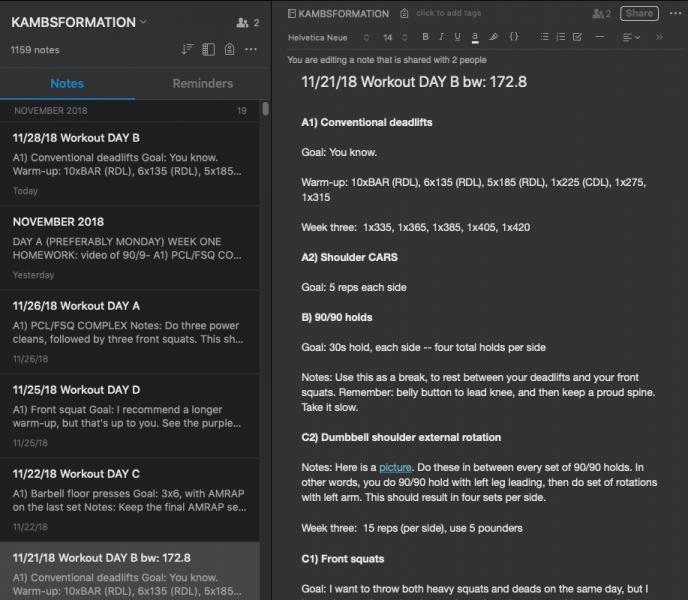This
post was originally published on
this siteOriginally posted at: http://www.nerdfitness.com/
I did it.
I proved somebody wrong on the internet!
I assume the internet will be mailing me a gold medal at any point this week, but until then, let me share the story.
I gave a TedX talk years ago, and I mentioned one of my long-term goals was being able to lift 400 pounds:

My first thought: “Ouch.”
My second thought: “Why am I reading YouTube comments!? No good can come of this.”
My third thought: “I’m gonna prove this person wrong.”
As a skinny nerd with chicken legs that couldn’t build muscle to save my life, this far-off goal suddenly seemed even further off.
Fast forward to last week: not only did I FINALLY reach my 10 year goal of deadlifting 400 pounds, I blew right past it. No straps, no belt. Just some chalk and “internet justice” rage:
For my final rep, I picked up 420 pounds at a bodyweight of 172 pounds. And it came up pretty quickly!

Now, I’ve internalized 5 big lessons on this journey to a deadlift I’m really proud of, especially considering all of those setbacks.
I wanted to share my lessons learned, and show you how you can apply this to your own life.
#1: Screw Your Genetics.

I have the genes of an elf, without the immortality.
If you’re familiar with body types, I’m an endomorph.
I’m naturally very thin and bony, have very thin wrists and ankles, and will forever have chicken legs.
This would be great, if I wanted to be a runner. Not great when you despise running, and you want to pick up heavy things.
Determined to overcome that fate, I began my journey to heavy lifting, only to get knocked back.
6 years ago, I discovered my genes also contain a super fun condition called “spondylolisthesis.”
Don’t bother trying to pronounce it, I still can’t.
It means my vertebrae don’t line up. Essentially, my L5 and S1 are less structurally aligned than a deep-game Jenga tower (Read how I used the “Iron Man Technique” when I got diagnosed).
Jenga: fun for game night, not for spinal metaphors.

When I first learned this, I initially assumed it meant my short lived career as a powerlifter was over, and threw myself one HELL of a pity party.
After that party ended, I got back on the horse.
(Not literally. I don’t have a horse.)
I started working on my deadlift form and core strength. I checked my ego, established a new “square one,” and essentially started over.
Thank god I refused to accept my fate.
Now, obviously I’m not a doctor – I don’t even have pants on right now – so you’re going to need to work with trained professionals if you have a serious medical condition you’re working to overcome.
In my instance, I decided that I didn’t want my genetics to decide my fate: that chicken legs and a crooked spine could be managed. While I might never reach my 10-year goal of a 400 pound deadlift, I’d get started and adjust along the way.
Yup, I know plenty of people can lift WAY more than I can. That’s cool! I’m competing against the ghost of my former self (like a Mario Kart time trial), and that’s all I can do.
I know I’m fighting an uphill battle when I focus on powerlifting when I’m much more likely to be good at running or another endurance activity. That sounds like my personal hell, so I’m gonna play THIS version of life on expert difficulty.
LESSON LEARNED: If you don’t like the game you’re playing, pick a different one! Who cares what your genetics are. You can’t do anything about them. All you can do is play the hand you’re dealt.
If you are a big-boned endomorph (you gain fat easily), and you want to be a marathon runner, GREAT! Start training for a 5k today. Who cares if you’re slow as molasses!
If you are built to run and want to strength train because that’s what brings you joy, go pick up heavy shit! Who cares if the person next to you can lift more? Are YOU lifting more than you did the day before?
We can only blame our parents for so much. Thanks for the crooked spine and acne, DAD.
(Kidding, my dad is cool as hell. He taught me to play poker when I was 5).
#2: Fail You Will. Learn, You Must.

After figuring out my spine sucked, I decided to hire my friend Anthony to coach me via email.
Because I couldn’t lift heavy to start, I had to reallllly focus on my form. It gave all of my muscles and tendons a chance to get caught up to speed.
So I spent two years making steady progress, which was awesome.
And then I went on vacation, where I severely strained my conjoint tendon.

Lesson learned: never go on vacation again.
My injury was so brutal that I was convinced I had a hernia. I ended up getting an ultrasound on my crotch from two female ultrasound technicians, which was in no way at all awkward.
Kidding. It was aggressively awkward.
Anyways.
After taking multiple weeks off from lifting anything heavy, I started rehab, checked my ego (again), and had to rebuild my form (again), going back 250+ pounds and starting over again.
I felt like Sysphysis, rolling a rock up a hill only to have it roll all the way back down.
Or Charlie Brown trying to kick a football:

But I kept at it. I learned to improve my form. I changed my breathing technique for lifting. And I accepted that I had to go backward in order to eventually break through.
For reference, click through these images and videos below. The “Before” took place before my injury, while the “After” is just a month or two back:
LESSON LEARNED: Always be learning, when you win or when you lose. Setbacks can be crippling, or they can be painful lessons learned that make you more powerful. I really didn’t have a choice.
You’re gonna get shin splints or plantar fasciitis when you start training for your 5k. Literally everybody does. Take it as a sign you need to fix your running form!
You’re gonna screw up on a lift. Take it as a chance to scale back and rework your form. Video tape your form and check with somebody
You’re gonna get sick and screw up and miss a lift or a hold or a thing. It happens. You can’t change the past (yet), so might as well learn from it and move forward. Rafiki gets me:

#3) Want to Reach a Far Off Goal? Use the Minecraft Strategy.

10 years ago, I had a goal I was racing towards: a 400 pound deadlift.
I’d get marginally closer and then have to back way off. This happened at least half a dozen times.
I believe the reason I finally achieved that goal is because I stopped focusing on rushing to get there! Instead, I just focused on the next workout, the next exercise, the next rep.
In other words: Don’t worry about the building you’re trying to construct. Instead, focus on putting the next brick in the right place, and then repeat. The building will take care of itself.
I call this the Minecraft Strategy.
As for my workouts, I train 4 days per week: Monday, Wednesday, Thursday, and Saturday. One hour per workout. Each day has a big boring lift attached to it that doesn’t change much at all from week to week.
For the past four years, here’s the deadlift portion of a training day (after many warm-up sets):
- Week 1: Sets of 2, 2, 2 for 220 pounds.
- Week 2: Sets of 3, 2, 2, for 220 pounds.
- Week 3: Sets of 3, 3, 2, for 220 pounds.
- Week 4: Sets of 3, 3, 3, for 220 pounds.
- Week 5: Sets of 2, 2, 2 for 225 pounds.
And repeat. Every week. Every month. For 5 years. Notice that each week I added just ONE rep. And once I hit 3 sets of 3, I’d go up by 5 pounds, and start back at 2, 2, 2.
That is boring as hell. And effective too. Every single week I’d be setting a personal best! I didn’t care about the far-off goal of a 400-lb deadlift, I instead put all of my focus into “Can I crush this next rep?”
This is also EXACTLY how one simply walks into Mordor: one step at a time.
Two weeks ago, my “slow cook” deadlifting workout had me doing 3 sets of 3 reps at 385 pounds.
Anthony told me: “Let’s go heavy next week. And I won’t accept anything less than 415 pounds.”
This was a goal I’d have forever, and Anthony had already set my sights 15 pounds heavier to calm my nerves on the psychological challenge of seeing that much weight on the bar.
So after picking up 405 for a warmup, I went for 420 pounds:
No belt, no straps. Just some chalk and Walk the Moon’s “Portugal” on my headphones. Honestly, it was almost a letdown because it came up so quickly…but I was so damn proud to reach a powerful milestone, banish the monkey on my back, and actually feel strong.
Hence the quick fist pump to myself.
This week? It’s back to the boring stuff. Boring, consistent, progress where I just get epic results and feel really good about myself.
I’m okay with that. I jokingly talk about how I went from Steve Rogers to Captain America with this slow, small tactic.
LESSON LEARNED: Are you a shiny-object chasing “I need to be entertained and I change workouts every 3 weeks but I can never seem to get results” type of person?

Fall in love with the process and incremental progress, and you’re gonna go places kid.
Each week, just focus on being better than you did the week before. If you ONLY worry about this, you’ll look back at the end of the year and realize you’re a changed person.
Note: This means you need to show up each week, with few exceptions. Even when life is busy.
#4 – Track the Problem to Crack the Problem.

Fun fact: I currently have a folder in Evernote called “Kambsformation” (Anthony came up with it, and it just stuck).
In that folder I have 1 note for every workout or progress photo from the past 5 years.
I now have 1159 notes in that folder:

As my friend Nick says, “You gotta track the problem to track the problem.”
I have tracked every single workout I’ve done since 2013 in this folder. I have them all in the same place, so I can quickly scan back to any date and time and see where I was, how I trained, and so on.
I know every week exactly what I need to do to be better than the week before. Using the Minecraft Strategy here, it just means I need to focus on ONE single rep heavier.
In addition to tracking my workouts, I’ve become diligent about tracking my calories too. I am not Paleo, or Keto, or Mediterranean.
Instead, I employ a “mental model” diet, with specific rules I follow:
- Skip breakfast. I cover this in our guide on Intermittent Fasting.
- Eat big after a workout. Adjust the rest of my calories based on goals.
- Protein with every meal. Usually chicken.
- Veggies with every meal. Brussel sprouts or broccoli.
- Adjust carbs and fat to fit macro profile for that day.
- A powerbomb shake to hit calorie goals. Water, oats, frozen berries, frozen spinach, and whey protein (I use Optimum Nutrition Vanilla).
Over the past 2 months, I’ve actually leaned out, from 185 pounds down to 172 pounds. I did that by adjusting my caloric intake very simply:
- 2600 calories on training days
- 2200 calories on non training days.
For the first few weeks, I actually didn’t lose any weight despite “tracking my calories.” I still believed in thermodynamics, so I started weighing my portions (I like this one) and discovered a few key things.
Namely, that I was overeating without realizing it:
- I was underestimating my oats portion by 20% when using a measuring cup instead of a scale
- My chipotle lunch contained 1.5 servings of rice by weight, not 1.
As soon as I made those small adjustments, my weight started to drop consistently.
In addition to tracking my food, I take progress photos weekly, and weigh myself each morning.
I don’t freak out if the scale goes up or down. Instead I take a 7-day rolling average and make sure the TREND is in the right direction.
Think of this like the bumper lanes in a bowling alley: As long as the ball is moving towards the pins, that’s good enough.

LESSON LEARNED: We pay attention to the things we track. So track the right stuff! This applies not only to health and fitness, but learning, personal finance, etc. Keep a journal, or an Evernote folder, or a Google Doc. Write down what you did, and what you’re going to do.
It’s valuable as hell. And I don’t care what kind of diet you pick: whichever one leads you to sustainable calorie management in a way that doesn’t make you want to punch a hole in the wall.
If the scale isn’t going down for you, it doesn’t mean that you have a slow metabolism, or that you’re broken. It means you are eating too many calories to induce weight loss. Track your calories more closely. Use a scale if you need to, until you learn what actual portion sizes are.
Are you taking progress photos? They can be a crucial for making sure you’re losing the right kind of weight!
Are you writing down your workouts or tracking them in an app? How else are you gonna know what you need to do this week to level up!?
#5) “It’s Dangerous to Go Alone. Bring a friend.”

I gotta give a shout out to my friend and coach, Anthony.
He’s been my online coach for the past 5 years and I truly consider him a valuable part of my success. He also has epic hair.
I’d say this is the best money I invest in myself each month – and I’m somebody that tells people how to exercise for a living!
When I’m traveling, or when I have busy weeks, my coach adjusts my schedule to make it work. When I am feeling good, well rested, and amped up, we crank things up. When I’m feeling overwhelmed he slows it down.
And most importantly, he doesn’t put up with my bullshit. You know what I mean – we all have excuses that we feed ourselves daily: too busy, I couldn’t because blah blah blah.
I know Anthony doesn’t want to hear this stuff, so I instead just DO the work! It’s pretty awesome to have somebody else that’s invested in my success, somebody that I can bounce ideas off of, somebody that I know is keeping me accountable, checking my form, etc.
And maybe most importantly, I have the peace of mind to know that I’m actually doing the right stuff, and doing it correctly. I feel confident saying I never would have lifted 420 pounds without my coach.
LESSON LEARNED: If you have the money to invest in yourself, hiring a coach who learns your story can be game changing. If you don’t, having a workout buddy in the trenches with you can be AMAZING too. An accountabilibuddy, if you will.
We’re proud that we have an online coaching program at NF, and we have an online community attached to our course, the NF Academy.
I also know lots of people who work with trainers in person and they can be worth every penny (sometimes!)
If you want to take your fitness more seriously, invest if you can. If you want to take running more seriously, join a running club.
You don’t have to go it alone on this journey, and oftentimes a coach or trusted friend can be an absolute game changer. It was for me.
I hope Anthony lets me keep him as a coach for the next 5 years too.
I proved a troll wrong, now what!?

So I mentioned that I proved somebody wrong on the internet. I mostly say this in jest.
The dude probably didn’t think twice about his comment, and hasn’t thought about it since.
Am I gonna try to right every wrong on the internet? Nope. People say really nasty things about me all the time, that just comes with the territory. It hurts like hell.
And then I get back to helping people and writing about Star Wars and sometimes wearing pants (but today is not that day).
So, although I jokingly say that “I owned that troll,” the reality is that it just. doesn’t. Matter.
I’m really proud of this accomplishment, and I hope my recap can help you crystallize the goals you have floating around your head.
These days, my goals are tighter, and more focused on the process:
- Work out 4 days per week, no exception.
- Hit my calorie goals 6 days out of 7 each week.
- Be better than the last workout.
I’m working on my handstands, mobility, and gymnastic rings stuff…but I’m gonna keep grinding on my deadlifts and squats too.
Considering how quickly that 420 pound deadlift came up, I wonder if I get a 500 pound deadlift…
No way, won’t happen. EVER. Not with these genetics 😛
(I’ll let you know in 5 years).
I’d love to hear from you: do you have a big “dragon slaying” goal you’re working towards in the future?
What can you take from this article and apply to your journey?
For the Rebellion!
-Steve
PS: We are hiring 2-3 certified coaches to join our NF Coaching Program! This is a 100% remote work-from-anywhere position. If you think you’d be a good fit, or know somebody that would, please check out our “work with us” page!
###
All photo credits can be found in this very special footnote[1].





































 For now classes are 6pm and 640pm at 2840 Wildwood st in the Boise Cloggers studio.
Book your class NOW!
click this ==>
For now classes are 6pm and 640pm at 2840 Wildwood st in the Boise Cloggers studio.
Book your class NOW!
click this ==>








